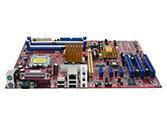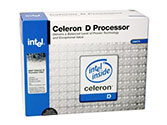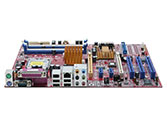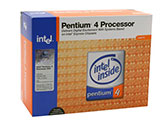Entry Level Buyer’s Guide, July 2005
by Jarred Walton on July 20, 2005 12:05 AM EST- Posted in
- Guides
Intel Recommendations
Not a whole lot has changed in the budget Intel market. Intel has had PCIe graphics for a while now, and we're still waiting for newer Celeron and Pentium chips with 64-bit support. (We're also waiting for Semprons with 64-bit support, though really we're not too concerned about the 64-bit factor for budget systems.)  |
 |
| Click images to enlarge. | |
Budget 775 Motherboard: Biostar I915P-A7
Price: $79 shipped
Budget 775 CPU: Intel Celeron D 330J 2.66GHz 256K L2 (Retail)
Price: $85 shipped (Retail)
Total: $164
Almost exactly matching the budget AMD setup in price, we continue with similar recommendations to our last budget Guide. The choice of CPU is less about performance than price, but the difference between the 2.53 GHz 325 and the 2.66 GHz 330J is only $4, so we go with the upgraded processor. You can see the complete list of Celeron prices on our Price Engine, and the next model up from the 330J adds $15, which is more than we're willing to pay for a budget setup.
The motherboard choice is the cheapest 775 motherboard that we could find with a few qualifications. First, it needs to be a PCI Express board, which generally means the 915P or 915G chipset. We avoid the 915GV chipset as that reduces performance by only supporting single-channel memory. The other requirement is that the board needs to have 4 DIMM slots of the same type, and for now, that means DDR. Some people may not mind the hybrid boards, but we like to have the ability to run 4x512MB of RAM in the future. The Biostar I915P-A7 fits all of those requirements and comes in substantially cheaper than most other competitors. Biostar also offers the I915G-M7 for those who want integrated graphics - as a business solution or a standby until you can add in a decent graphics card, the extra $6 is a good deal.
The only other boards that are priced similarly are from Jetway (915PCP/GCP), ECS (915G-M), Foxconn (915G7MC-S), and Aopen (i915Pa-E) - we may have missed one or two boards, but the point is that there aren't any name brands like ASUS or MSI in this price range. None of these are really better than the Biostar in our opinion, and they all cost a bit more.
If you like the idea of integrated graphics but want more performance, the ASUS P5RD1-V uses the ATI Xpress 200 chipset and may be worth consideration. The price of $100 makes it a moderately expensive upgrade, and if you're looking at an IGP solution you probably don't care much that the Xpress 200 is twice as fast in several gaming benchmarks - a discrete graphics card will still outperform the IGP with relative ease. As with the MSI Xpress 200 board for AMD, we don't expect much in the way of overclocking due to the chipset. Overclockers should probably look to the more recognized enthusiast brands like ASUS, DFI, MSI, etc. and get an Intel chipset, though you'll also have to pay over $100 for those.
 |
 |
| Click images to enlarge. | |
Upgraded 775 Motherboard: Biostar I945P-A7
Price: $98 shipped
Upgraded 775 CPU: Intel Pentium 505 533 FSB (Retail)
Price: $134 shipped (Retail)
Total: $232
Our upgraded Intel platform takes a bit different approach than the past. Price is once again equal to the AMD side of things, but we spend more on the motherboard and less on the CPU. We cut the CPU from the Pentium 520 of previous Guides (2.8 GHz 800FSB with HyperThreading) to the 505 (2.66 GHz 533FSB and no HyperThreading). HTT is sort of interesting, but the extra $40 to upgrade to the 520 is pretty significant. Actually, the 530J is only a couple of dollars more than the 520, so if you do go for the faster processor, the 530J is the better buy. Performance of the 505 is reasonable, though clearly outclassed by the Athlon 64 processors. Part of the reason why we like the 505 is that you can get some great overclocking results from it on virtually any motherboard. The processor has a 20X multiplier, so combined with a bus speed of 166 to 200, you can shoot for 3.33 GHz to 4.0 GHz. The upper end of that range may be difficult to reach, but 3.4 to 3.6 GHz is pretty reasonable for the 90nm Prescott design.
Along with the switch to a slightly slower CPU, we've included the cheapest DDR2 board that we could find for future compatibility, and it also uses the new 945P chipset. The switch to DDR2 will increase the price slightly relative to DDR, but even AMD will be moving to DDR2 early next year, so you should be able to use the RAM in a future system. Integrated graphics versions of the chipset are also available with the 945G series, with the most affordable options coming from ASUS (P5LD2-VM) and Intel themselves. The cheapest 945G models are micro ATX form factors, allowing the use of a smaller case like the Aspire X- QPack that we recently reviewed, as well as any other uATX case. (You can always put the small motherboard in a full-size ATX case if you prefer.)
The 945 chipsets all support dual core CPUs, providing another future upgrade path. With the cheapest Pentium D starting at well over $200, we can't recommend such a CPU for a budget system yet, but we expect prices to drop over the coming year, making it a viable upgrade in 2006. If you go with the budget Intel recommendation, you're stuck with single core processor support for as long as you own the system. Of course, some people never upgrade individual components and prefer to replace the entire system every few years. If that describes your purchasing habits, there's not much point in buying more future-proof components.










57 Comments
View All Comments
Budman - Wednesday, July 20, 2005 - link
Nice setups. :)Jarred you should also tell eveybody that the AMD Sempron 2800+ and below doesnt support cool & quiet while Semprons 3000+ and above do support Cool & quiet.
Might be important to somebody to have it cool & quet.
Grandpa - Wednesday, July 20, 2005 - link
Why not just buy a Dell? By the time you buy an Operating System, virus program, word processor, and all the other software needed, it seems like a refurbished H-P or Dell would be better.Any thoughts?
crimson117 - Friday, July 29, 2005 - link
Some people already have the software they need, and don't want to pay dell for it.xsilver - Wednesday, July 20, 2005 - link
do the s754 with PCI-e have low availablity/demand?havent seen them where I am (australia)
shoRunner - Wednesday, July 20, 2005 - link
i think i'd be much smarter to go with a cheap case (Skyhawk/Eagle has a nice aluminum one for $30) and a cheap Fortron PSU(~$25) and buy keyboard/mouse/speakers separate (OEM Logitech Keyboard and mouse combo $10, speakers $5). Ends up only $1 more than the Codegen combo and you don't have a PSU that may(and probably will) crap out on your possibly damaging your system.shoRunner - Wednesday, July 20, 2005 - link
Manzelle - Wednesday, July 20, 2005 - link
Well done.